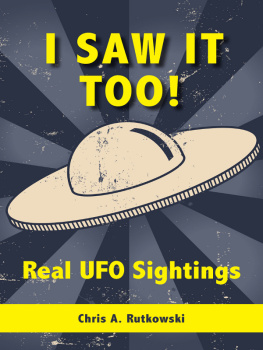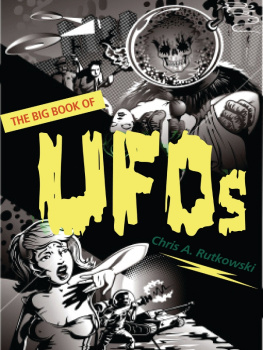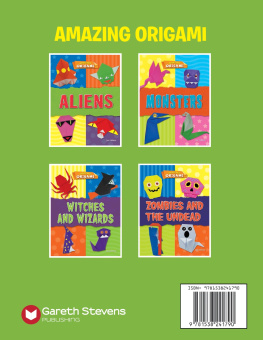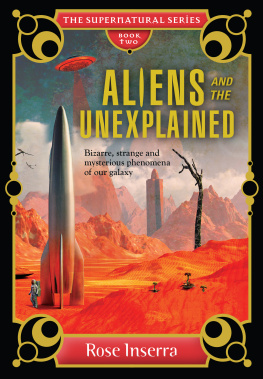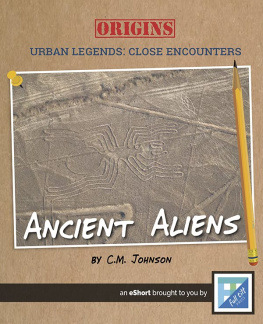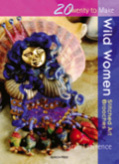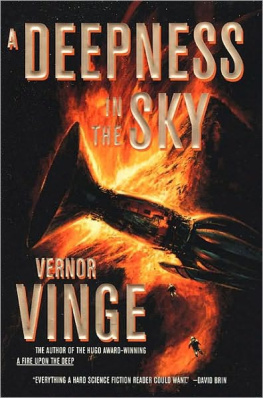Abductions and Aliens
Abductions
&
Aliens
Whats Really Going On?
Chris A. Rutkowski
with a foreword by John Robert Colombo

Copyright Chris A. Rutkowski 1999
All rights reserved. No part of this publication may be reproduced, stored in a retrieval system, or transmitted in any form or by any means, electronic, mechanical, photocopying, recording, or otherwise (except for brief passages for purposes of review) without the prior permission of Dundurn Press. Permission to photocopy should be requested from the Canadian Copyright Licensing Agency.
Publisher: Anthony Hawke
Design: Scott Reid
Printer: Transcontinental Printing Inc.
Canadian Cataloguing in Publication Data
Rutkowski, Chris
Abductions and aliens: whats really going on?
ISBN 0-88882-210-3
1. Alien abduction. I. Title.
BF2050.R87 1999 001.942 C99-932210-3
1 2 3 4 5 03 02 01 00 99
We acknowledge the support of the Canada Council for the Arts for our publishing program. We also acknowledge the support of the Ontario Arts Council and financial support of the Government of Canada through the Book Publishing Industry Development Program (BPIDP) for our publishing activities.
Care has been taken to trace the ownership of copyright material used in this book. The author and the publisher welcome any information enabling them to rectify any references or credit in subsequent editions.
J. Kirk Howard, President
Printed and bound in Canada.

Printed on recycled paper.
Dundurn Press
8 Market Street
Suite 200
Toronto, Ontario, Canada
M5E 1M6
Dundurn Press
73 Lime Walk
Headington, Oxford,
England
OX3 7AD
Dundurn Press
2250 Military Road
Tonawanda, New York
U.S.A. 14150
For Zachary... may you never stop asking questions
TABLE OF CONTENTS
by John Robert Colombo
ACKNOWLEDGEMENTS
There are many people whom I would like to thank for their assistance, either direct or indirect, in the preparation of this book.
These include: Mary Anderson; my mentor Chester Cuthbert; Geoff Dittman; Lorraine, Sean, and Allison Fair; Geoff Green; my dear friends Jeff and Linda Harland; Jimmie Holman, Jim Melvin, and Sean Jones for Internet and computer assistance; Jon OQuetwa, Pamela Sindriglis, Andrew Tugby, and Lorraine Welch from the IRC gang.
I would like to thank members of my writers group (SDGE) for their support, encouragement, proofreading, and comments, not only on this project, but also my other writing efforts during the past few years. These include Katharine Carr, Fatima DeMelo, Susan Rocan, Kevin Russell, and Evelyn Woodward. I must thank Crystal Rocan for her special help, too.
Thanks are due to John Robert Colombo for his foreword, his comments, and his encouragement, and to my publisher, Tony Hawke.
A special thanks to louise sherman (lowercase but definitely upper echelon), who helped me a great deal during the preparation of the manuscript, to Kelley Grandmaison, and to Vladimir Simosko, who was always there with some wisdom and ideas.
... and a thank you to Nancy...
FOREWORD
by John Robert Colombo
From the beginning of recorded history, our species has raised its eyes to the heavens and marvelled at the cycles of light and dark, considered the apparent movements of the sun, the moon, and the planets, and paused to wonder about the stars. Especially the stars, which are so incredibly distant and remote from us. The paradoxical stars, which seem to be fixed in the firmament and yet seem to twinkle and wink at us. These stars, so tiny in the night skies and yet so immense in space. We cannot help but wonder about the nature of the connection, if there is a connection, between the overpowering stellar array and the puny affairs of our species on this tiny planet we call Earth. We cannot help but wonder if there could be any cosmic connection at all.
To overcome this sense of remoteness in the universe, we have given some of the more prominent stars their own names. The ones that are visible to the naked eye have been grouped into constellations and christened with names taken from local mythologies. Constellations of stars fill the sky, visible by night, invisible by day. Eighty-eight constellations are known to astronomers, twelve to astrologers. The distances of the stars from Earth are so immense that the void and vastness of the cosmos are both chilling and bracing. The cosmos chills to the bone with proof that man is nowhere near the centre of all creation because there is no centre; the cosmos braces man for the fact that he may be alone in the universe, an orphan of the cosmos. He may be all alone, but then again he may not be. The French writer Albert Camus has one of his characters in the desert of North Africa raise his eyes to the night sky and feel the benign indifference of the universe.
Is the universe benign? Is it indifferent to the human species? Or is there some grand plan that has assembled the stars those distant suns that influences and guides the betterment of the human species on the planet Earth? Is there life on the planets that are now understood to circle around many of those remote suns? Is that life at all Earth-like?
To try to answer such questions we must define what we mean by lifeforms. Earth swarms with life from the mosquito to the great whale, from the dinosaur to the kangaroo, from a blade of grass to a rose bush, from a virus to an enzyme, from a microbe to a bacterium, from a pterodactyl to a meadow lark, from a man to a woman... there is no shortage of life on the planet Earth, though some unique species have been extinct for millions of years and others are endangered and on the point of extinction in our own time. Current opinion holds that none of the planets in our solar system (though possibly some of their moons) are likely to be the abode of life.
There may be lifeforms on the planets of other solar systems.
If there is life elsewhere in the universe, and if off-Earth life has evolved as has human life on the planet Earth, then it is as likely as not that there are non-human beings who live in those worlds and look up to the sky speculating about the forms that life may have taken on planets like Earth that are distant from them. These non-human beings are called aliens. We on Earth have always seen strangers as aliens, though in the past the strangers we have met on Earth have hardly been strange at all! Strangeness is not merely a matter of skin colour, cast of features, languages spoken, social customs, religious beliefs, cultural concerns, or civilized values that are taken for granted but seldom easily granted to the other, to alien beings.
Aliens from distant planets would appear to us to be alien indeed! In the Earths oldest scripturespoetic works like the Vedas and some of the books of the Old Testamentthere are descriptions of such beings, or at least there are scholars and popular writers who maintain that this is so. Such beings are the Elohim who descended to Earth where they married the daughters of man. What do we make of the Vision of Elijah, of wheels within wheels, and of his assumption into the heavens? In the late Middle Ages in England, there is an account of the Green Children who seem to have emerged from a deep cave to visit a little English village. The Ojibwa of the Rama Reserve, near Orillia, Ontario, have a traditional story about the Skyman who descended for a three-day visit and then ascended in some sort of craft. Such descriptions are generally taken to be poetic expressions, not factual accounts of what might well have been.
Next page

